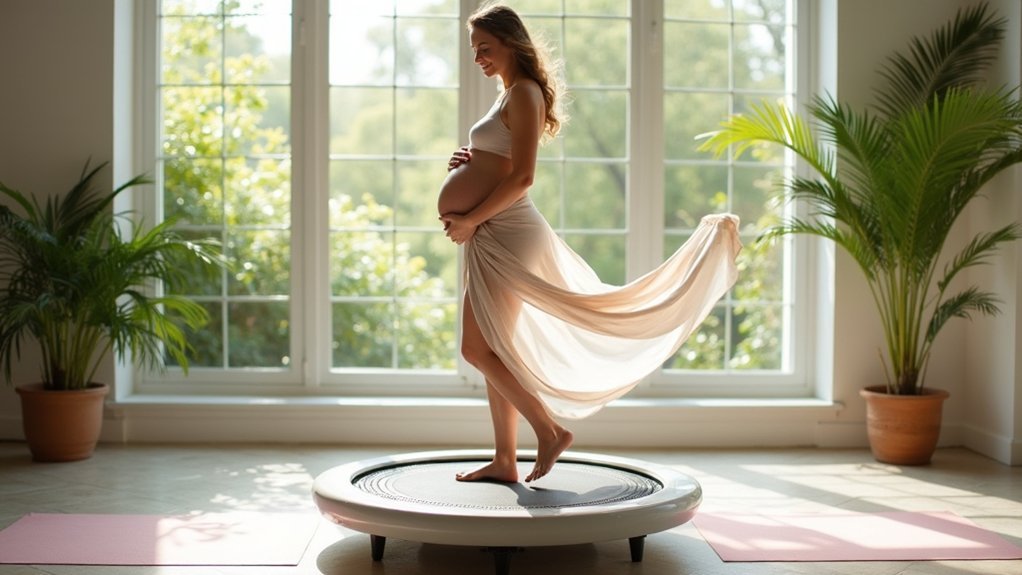Gentle bouncing during your second trimester strengthens core muscles while minimizing pelvic floor strain. Always consult your healthcare provider first to confirm it’s safe for your specific pregnancy. Use a rebounder on a flat surface with a support bar nearby, and wear supportive shoes. Alternate 2-minute rebounding intervals with stability ball exercises, maintaining proper posture throughout. Stop immediately if you experience dizziness, bleeding, contractions, or decreased fetal movement. The following workout guide provides everything needed for a safe rebounding routine.
Why Gentle Bouncing Benefits Your Second Trimester Body

While many exercise options become increasingly uncomfortable as your pregnancy progresses, gentle bouncing workouts offer unique advantages for your changing body during the second trimester.
The controlled up-and-down motion strengthens your core muscles while minimizing pelvic floor strain through reduced vertical impact.
You’ll also counteract pregnancy’s notorious lower back curve as bouncing promotes proper spinal alignment and engages your glutes for better hip stability.
Your circulation gets a significant boost too. The rhythmic movement enhances blood flow, potentially reducing leg swelling and improving oxygen delivery to your placenta.
Beyond physical benefits, you’ll enjoy natural stress relief as bouncing triggers endorphin release while lowering cortisol levels.
These gentle movements also prepare your body for birth by improving pelvic mobility and building stamina for labor. However, be mindful that any unintentional leaking of urine during exercise should not be ignored and may indicate you need to modify your workout intensity.
Assessing Your Readiness for Pregnancy Rebounding
Before you step onto a rebounder during your second trimester, check with your healthcare provider to confirm it’s appropriate for your specific pregnancy.
Your prior exercise experience matters—those who regularly exercised before pregnancy will likely adapt more easily to rebounding than those who were sedentary.
Complete a simple balance self-assessment by standing on one foot for 30 seconds to evaluate your stability, which is essential for safe rebounding exercises.
Rebounding offers excellent benefits for rebuilding pelvic floor strength after pregnancy, so starting in your second trimester with approval may provide continuity in your fitness journey.
Check With Healthcare Provider
Consulting your healthcare provider represents the essential first step before beginning any bouncing workout during your second trimester.
Your doctor will evaluate critical factors like placenta position, cervical status, and any pregnancy complications that might make rebounding unsafe.
Bring questions about your specific limitations and be prepared to discuss your pre-pregnancy fitness level.
Your provider should assess for conditions like preeclampsia, gestational diabetes, or joint instability that require exercise modifications. They’ll also review medications that might affect your balance or coordination.
During your appointment, expect a thorough evaluation of your current pregnancy status, including recent ultrasound findings and fetal position.
Your doctor will establish safe heart rate limits and monitoring protocols tailored to your unique pregnancy journey.
Remember that activities with extensive jumping, hopping, or bouncing should be limited during pregnancy for safety reasons.
Prior Exercise Experience
Your exercise background plays a significant role in determining how to approach rebounding workouts during your second trimester.
If you’ve been rebounding before pregnancy, you’ll likely adapt more easily than someone completely new to this activity.
When evaluating your readiness, consider using pregnancy-specific tools like the PAR-Q Plus for Pregnancy or the Get Active Questionnaire for Pregnancy (GAQ-P).
These validated questionnaires help determine if you need medical clearance before starting.
For those with prior rebounding experience, focus on modifying your existing routine rather than beginning an entirely new program.
The GAQ-P is specifically designed to identify women who may need healthcare consultation before engaging in physical activity during pregnancy.
You’ll want to adjust intensity using the talk test—if you can’t maintain a conversation while bouncing, you’re working too hard.
Heart rate monitoring and perceived exertion scales also provide valuable feedback to guarantee your workouts remain safe as your pregnancy progresses.
Balance Self-Assessment Test
Balance assessment forms a critical foundation before starting any rebounding workout during your second trimester. Your stability capabilities have shifted since pre-pregnancy, requiring updated evaluation before bouncing exercises.
Try these progressive tests at home with a chair or wall nearby for support:
- Stand with feet together for 30 seconds
- Perform a modified tandem stance (heel beside opposite foot’s midpoint)
- Reach forward 6-8 inches without stepping (less indicates balance concerns)
If you struggle with these tests or take longer than 12 seconds to stand up, walk 10 feet, and return to sitting, modify your rebounding routine. The inability to maintain a tandem stance for 10 seconds indicates higher fall risk during rebounding exercises.
Remember that hormone-induced ligament changes affect balance even before your baby bump markedly shifts your center of gravity.
Always prioritize safety over challenge during pregnancy rebounding sessions.
Setting Up a Safe Bouncing Environment at Home
When preparing your home for prenatal bouncing workouts, safety must be your top priority. Place your rebounder on a flat, even surface and secure it with non-slip mats.
Maintain 3-4 feet of clearance around the equipment, away from walls and furniture to prevent collisions.
Ensure proper ventilation with room temperature between 68-72°F, and keep a phone nearby for emergencies.
A comfortable environment with good air flow and emergency communication access ensures both safety and peace of mind during prenatal workouts.
Wear cross-training shoes with good arch support or silicone grip socks if you prefer going barefoot.
Install a sturdy support bar for balance and keep your bounces low—no more than 2-3 inches high.
Store loose items away from your workout zone and consider using mirrors to monitor your form without twisting your body.
Since pregnancy increases your risk of balance issues, remember to avoid jumping, bouncing exercises that include sudden jerky motions as your pregnancy progresses.
Six Low-Impact Rebounder Routines for Pregnant Women

These six gentle rebounder exercises offer safe, effective workouts tailored specifically for second-trimester pregnancy.
- Supported Heel Taps: Stand with feet wider than hip-width apart and gently tap alternating heels, keeping your core engaged.
- Standing Arm Circles: Maintain balance on the rebounder while performing slow arm circles to improve upper body circulation.
- Gentle Knee Lifts: With a hand on a nearby wall or chair, perform slow knee lifts without actual jumping.
- Side-to-Side Weight Shifts: Shift weight from foot to foot while maintaining contact with the rebounder mat.
- Seated Bounces: Sit on the rebounder and gently bounce using your legs for lymphatic benefits. Always ensure your rebounder has a safety handlebar installed to prevent falls or loss of balance during pregnancy.
- Stationary Marching: March in place with minimal lift, focusing on controlled breathing throughout.
Remember to consult your healthcare provider before starting and modify as your pregnancy progresses.
Combining Stability Ball Work With Rebounding Techniques
Combining a stability ball with rebounding exercises creates a powerful duo for second-trimester fitness that addresses multiple prenatal needs simultaneously. This pairing enhances your balance while engaging your core muscles—crucial as your center of gravity shifts.
Start with gentle bouncing on your rebounder for 3-5 minutes, then shift to wall ball squats to strengthen your legs and glutes. Between bouncing sessions, perform core ball rollouts to maintain abdominal strength without strain. Regular exercise during pregnancy can help position your baby optimally for natural birth and reduce complications. Always maintain proper posture during both activities.
Begin your session with 3-5 minutes of gentle rebounding, followed by wall ball squats and core rollouts to build strength while protecting your changing body.
For ideal results, alternate between 2-minute gentle rebounding intervals and 1-minute stability ball exercises. Finish with child’s pose using the ball for support.
This combination delivers cardiovascular benefits while preparing your body for later pregnancy stages—just remember to get your doctor’s approval first.
Warning Signs to Stop Your Bouncing Workout Immediately

While rebounding workouts offer excellent benefits during your second trimester, recognizing when to stop is just as important as knowing how to exercise correctly.
Cease activity immediately if you experience vaginal bleeding, dizziness, contractions, or fluid leakage. These could indicate serious complications requiring medical attention. Don’t ignore chest pain, irregular heartbeat, or persistent shortness of breath.
Your changing body needs special attention. Stop if you notice excessive pelvic pressure, urinary leakage, or a bulging sensation in your pelvic area—these signal pelvic floor stress. Remember that hot exercise environments should be avoided during pregnancy, including heated rebounding classes.
Balance issues, round ligament pain, or joint instability also warrant stopping. Always monitor your baby’s movements. If you notice decreased fetal activity, uterine cramping that doesn’t subside with rest, or multiple Braxton Hicks contractions, end your workout immediately.
Frequently Asked Questions
Can I Continue Bouncing Workouts if I Have Placenta Previa?
No, you shouldn’t continue bouncing workouts with placenta previa. They’re contraindicated due to bleeding risks. Consult your doctor immediately and switch to approved alternatives like stationary cycling or water aerobics instead.
How Should I Modify Exercises for Twin Pregnancies?
With twins, you’ll need to lower exercise intensity, prioritize pelvic floor work, and modify core exercises. Use supports for balance activities, focus on swimming or prenatal yoga, and listen carefully to your body’s signals.
Will Bouncing Exercises Help Position My Baby for Delivery?
Yes, controlled bouncing can help position your baby for birth. The gentle movements encourage cephalic presentation, while pelvic tilting motions create space for ideal fetal alignment and rotation into an anterior position.
Are There Weight Limits for Pregnancy Rebounders?
Yes, rebounders have weight limits, typically 113-130 kg. During pregnancy, you’ll need to take into account your increasing weight against these limits. Always check the manufacturer’s specifications and prioritize your safety when rebounding.
How Soon After Bouncing Exercises Can I Resume Intimate Relations?
You can resume intimate relations when you feel physically recovered and comfortable after bouncing exercises. There’s no specific wait time—listen to your body and prioritize your comfort. Always consult your healthcare provider for personalized advice.
In Summary
Bouncing workouts offer a gentle yet effective way to stay active during your second trimester. Listen to your body’s signals and don’t push beyond your comfort zone. Remember to check with your healthcare provider before starting any new exercise routine. With proper precautions and modifications, you’ll enjoy improved circulation, reduced swelling, and better mood – all while keeping yourself and your baby safe throughout your pregnancy journey.





Leave a Reply